NATIONAL IRRIGATORS’ COUNCIL
MOVING FORWARDS: OUR REVIEW OF THE MURRAY DARLING BASIN PLAN
Advocating for the Australian irrigated agriculture industry

NATIONAL IRRIGATORS’ COUNCIL
Advocating for the Australian irrigated agriculture industry

The Murray-Darling Basin Plan forms part of a multi-decade water reform journey, and exists amongst a broader architecture of water management instruments at State and Federal levels. It is due for Review in 2026 by the Murray Darling Basin Authority.
"Moving Forwards: Our review of the Murray Darling Basin Plan" by NIC, is a series of comprehensive papers based on the key themes identified by the MDBA in their Early Insights Paper, as well as a chapter on Community and Agriculture which was overlooked in the Early Insights.
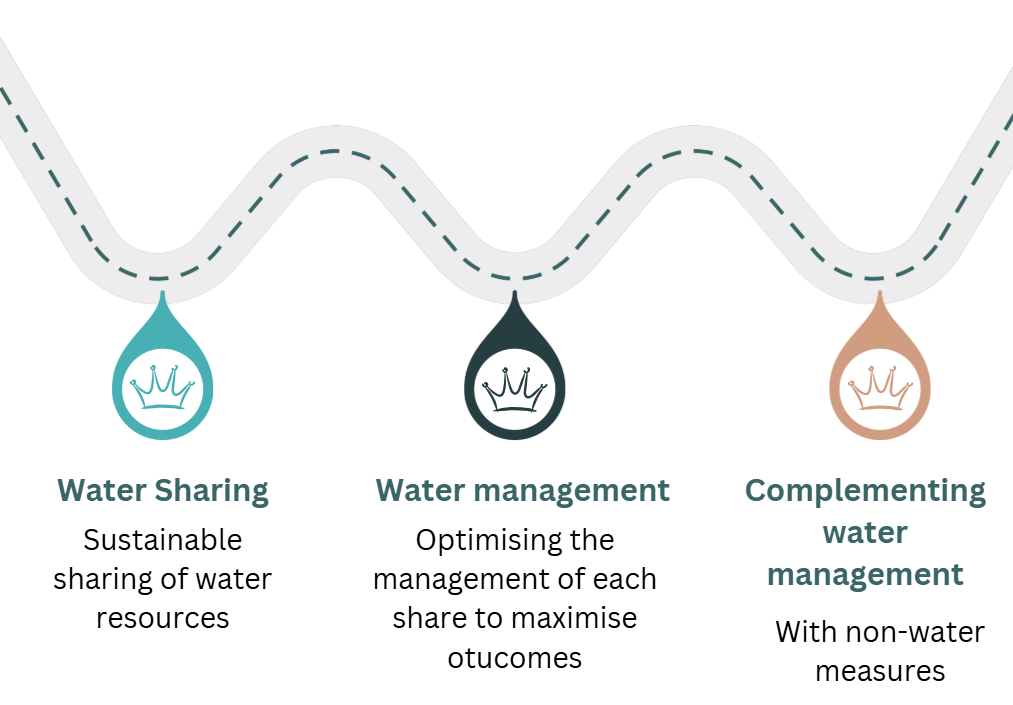
These papers, together with material from the MDBA and other stakeholders, should help start conversation on how to enable improvements in the Basin Plan to support strong and vibrant communities and enhance environmental outcomes with the water already held for environmental purposes.
At the core, our review is based on a new, systems-thinking, framework developed by our team - the 'Triple Crown Water Reform Framework'. The framework is described in detail in our published article and further within our Basin Plan Review - Regulatory Design chapter. Our review also importantly considers the following key questions:
Challenges with the current design and recommendations for improvement.
The core objective of the Basin Plan and how they are being implemented..
Recognising existing mechanisms and levers.
Achievements and challenges in environmental water, and whats next to enhance outcomes.
Assessing the opportunity cost of current approaches to achieving environmental outcomes.
First Nations, managing the northern Basin and water quality.
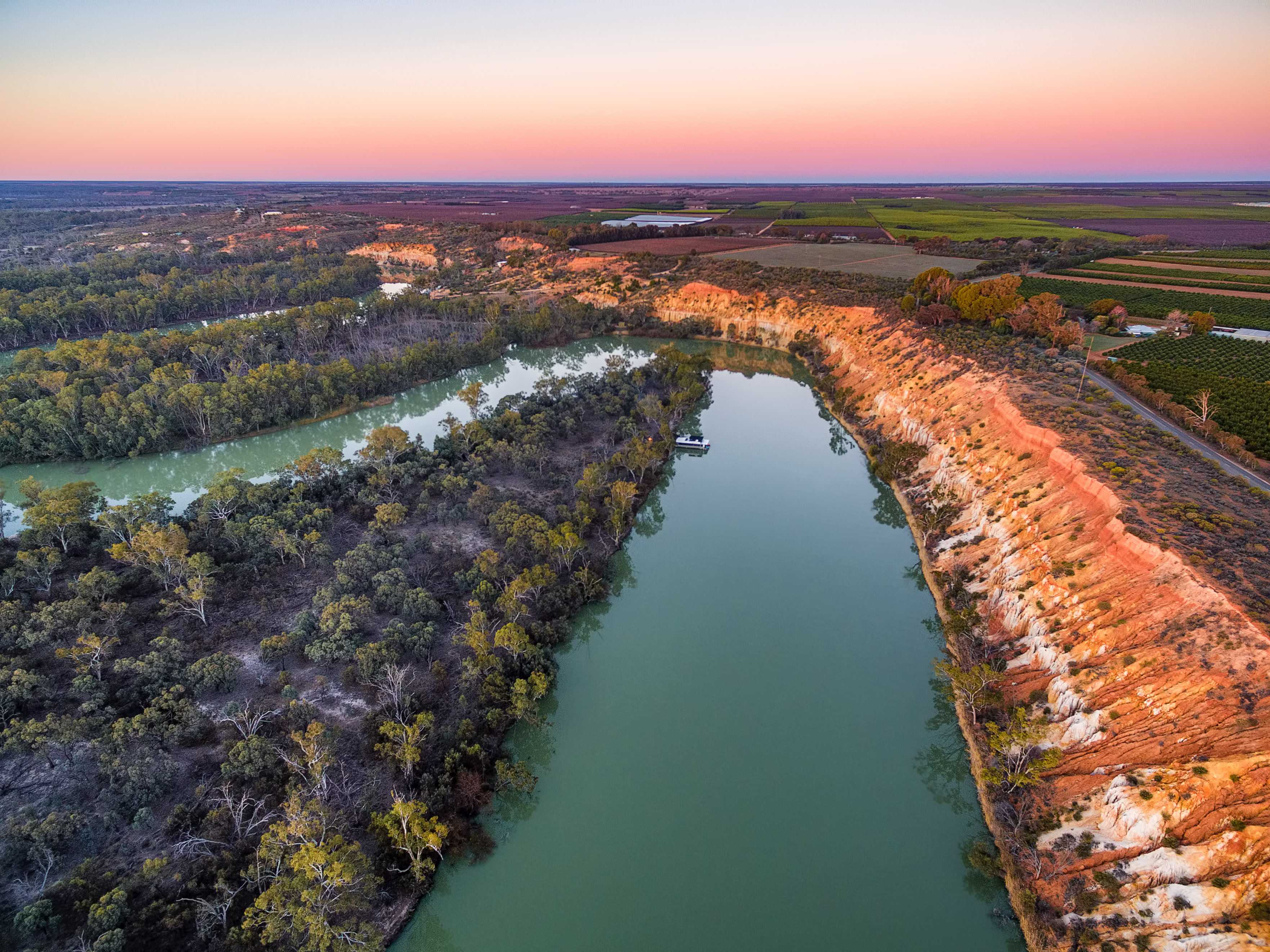
In our view, a key shortcoming of the Plan was the assumptions that equated returning water volumes with ecological outcomes directly, with a lack of recognition or adoption of the other mechanisms required, and a lack of flexibility to adopt innovations to avoid irreversible community and industry impacts, and achieve the same or better outcomes. Unpacking this assumption will provide essential pathways forward for the Basin.
Furthermore, NIC was concerned that the Plan will be reviewed against objectives it was never intended to achieve, or cannot achieve, on its own – given the broad spectrum of expectations which have developed over time about the Plan. This risks under-recognising the significant changes which have occurred from the Plan, as well as not properly understanding the nature of contemporary issues and how to address them.
In summary of our findings:
NIC is of the position that the Basin Plan has achieved its core objective – to establish sustainable levels of water use – achieved through substantial reductions in water diversions as a result of water recovery (and other means).
The achievement of this 'core objective' has come at a cost to irrigation-water dependant communities and industries, with some impacted more than others. Whilst socio-economic impacts are variable around the Basin, we are concerned that there are communities and industries more vulnerable to further changes in water availability than before the Plan.
It has also become evident that expectations on the Basin Plan have grown over time, leading to a ‘scope-creep’ in what people perceive the Basin Plan to be solving, and able to solve. This does not mean the Basin Plan has failed, but an opportunity to move forward.
This opens up the opportunity to look beyond the initial driver for the Basin Plan, and allows the next chapter for the Basin to turn to the contemporary issues, focused on optimal management of the resource within the water sharing framework, and enhancing those outcomes with integrated management regimes.
Doing this will require turning the chapter from a ‘plan of water recovery’ to a ‘plan of management’ for the Basin, drawing on a wider array of levers (i.e. complementary measures).
NIC Recommends the Triple Crown of Water Reform Framework be adopted to structure the Basin Plan Review, and future water management in the Basin.
NIC Recommend that the future focus of the Basin Plan should be on Crowns 2 and 3 - Improving ecological and other outcomes from the environmental water already available.
Add your content here.
A new framework - The Triple Crown of Water Reform Framework - is a multi-stage Framework, which recognises that the broader outcomes desired to be achieved by addressing overallocation in a river system, extend beyond rebalancing water quantities itself, to ecological and other outcomes and values. This extension requires not only sustainable water shares, but the optimal use and management of those shares, and the furthering of outcomes to include direct targeted initiatives.
.png)
The Triple Crown of Water Reform Framework provides a valuable tool to structure the Basin Plan Review, and future water management in the MDB.
The Basin Plan Review, and any subsequent versions of the Plan, should see progression to Crowns 2 and 3 as the next chapter of reform, celebrating the successes of Crown 1.
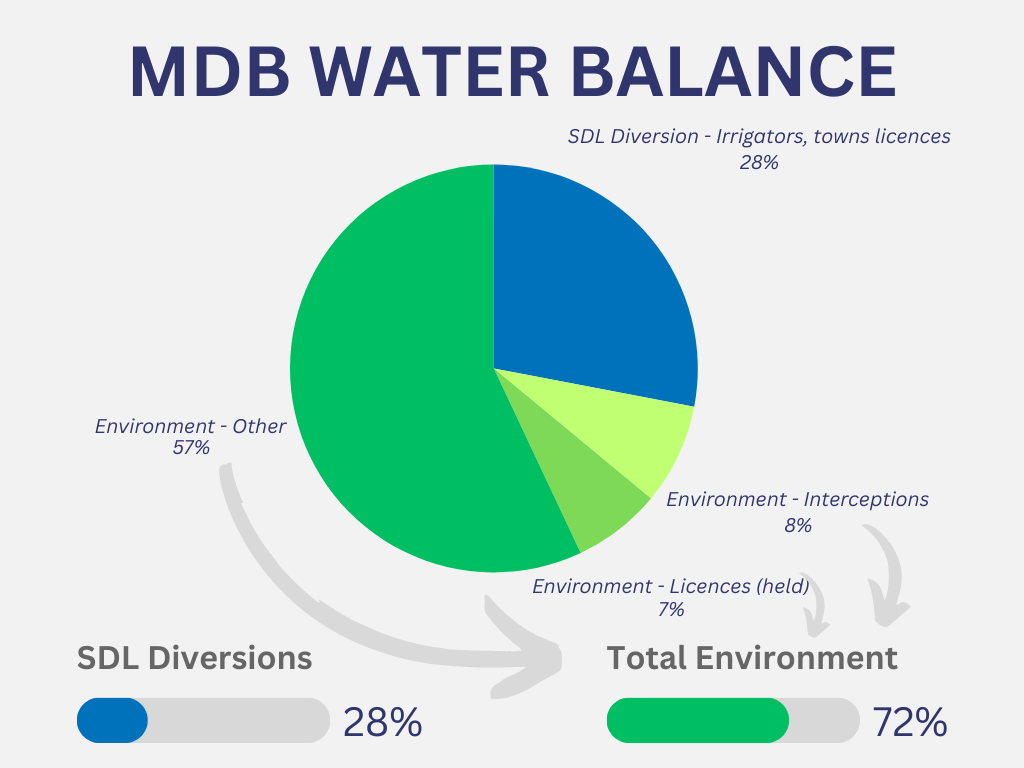
.png)
.png)
The Basin Plan has done its job in terms of addressing ‘over-allocation’, which was the core issue at the time of it’s conception (during the Millenium Drought). In fact, combined with pre-Plan water recovery programs, there has been a transfer of nearly one-third of consumptive water entitlements to the environment. This means we can move forward with the limits we have, and onto to the next chapter of water management, beyond just water sharing and rebalancing, to look at how each share of water is managed.
The below shows general security water allocations in four regulated water sources, varying over time in response to climatic conditions (note: allocations in blue, carryover in orange). This is (a) NSW Murray; (b) Gwydir; (c) Murrumbidgee; (d) Macquarie.
It will be integral that any review of the Basin Plan recognises the ways in which climate change is already factored into water management, as the starting point for the review. This is not to say ‘everything will be fine’, rather, to ensure an accurate information base of possible future scenarios (not just of water availability, but how this trickles down through water sharing frameworks to produce different outcomes for different users). NIC is concerned by a view that the Basin Plan and water management do not consider climate change – this is not correct.
Managing for climate change is not about ensuring a set of benchmark environmental outcomes in the Basin continue to be achieved. All users must share risks and opportunities. NIC agrees with the questions in the Early Insights Paper that:
“can these [achievement of Basin Plan environmental outcomes] be better mitigated and responded to, or will some desired environmental outcomes not be sustainable under climate change?”
Climate change planning must also focus on water security for critical human needs (including First Nations), and water security for agriculture. Even under the most extreme climate scenarios, it will be important to maintain a viable agricultural sector. Under current management arrangements, where water allocations to consumptive users are lowest-priority, the irrigated agricultural sector will be hit first and hardest.
NIC recommends that the review includes modelling of what water allocations for agriculture will look like under these various climate scenarios (including availability and affordability), and what this will mean for the industry. This will be important to: (i) understand the status quo; and (ii) determine if interventions (of some form) are necessary to improve water security for agriculture, to maintain production into the future. Indeed the water security limitations on Australian agriculture are a vital piece of information for Governments to ensure domestic food security and food sovereignty, as well as to maintain a strong export base.
In our view, focus must be on securing critical needs during droughts (including critical environmental needs, but foremost, critical human needs such as town water supplies). In extreme events, critical human needs are the highest priority. Integral to this, is recognizing that securing these high-priority needs cannot occur with the buyback of more licenses which are lower priority than those needs already. This will require a more comprehensive look at a range of solutions, including infrastructure (storage dams, weirs, pipelines, tanks), secondary supply sources, water recycling, desalination, or water-carting as a last resort. This will require working with local councils, who are primarily responsible for town water supply.
When referring to ‘plausible climate futures’, this must include both wetter and drier periods, as well as acknowledge the uncertainty in projections. There is a tendency for focus to only be on the drier.
.png)
.png)
.png)
.png)
“Water for the environment is essential, but on its own is likely not sufficient. Factors such as water quality, riparian and floodplain management, pest control, instream habitat, river operations, constraints and works, and environmental water portfolio management are also crucial to achieve environmental outcomes.”
1 in 3 litres of irrigation water has now shifted out of agricultural production in the Murray Darling Basin,
to the environment.
This means on average 72 percent of river flows are for environmental purposes through rules and licences.
30% of the 10,801.5 FTE jobs lost across 40 southern Murray-Darling Basin communities from 2001 to 2016 were attributed to water recovery for the environment.
50% reduction in the number of agricultural businesses in the Basin between 2006-07 to 202-21, as businesses adapt to farmers with less water.
An entire class of high-school students has been lost on average in every NSW southern MDB region over the implementation of the Basin Plan.
Recovering an additional 760GL would have an average annual foregone production cost of over $850 million per year. This is an extra 17,500 hectares of high-value horticulture being dried off in a repeat of the Millennium Drought.
Now the Basin Plan water recovery has largely been complete (Bridging the Gap), and SDLs are complied with, this ‘heavy lifting’ has been done, and water management efforts can now pivot to focus on other management actions which have greater community support, and without the socio-economic impacts.
This Chapter looks at a range of contemporary and/or emerging issues for the Basin, including:
a) First-Nation's outcomes;
b) Managing the northern Basin; and
c) Water quality.
See the full chapter for specific findings and recommendations on each.
Full compliance with SDLs across the Basin
Status: Achieved (ongoing monitoring)
Status: Partial / in progress (ongoing implementation of constraints and supply projects)
Status: Limited / ad hoc (need for significant investment)
Ultimately, the Basin Plan has achieved what it set out to do – to reduce diversions to sustainable diversion limits. This has come at a cost to irrigation-water dependant communities and industry, with some more impacted than others.
It has become evident that expectations on the Basin Plan have grown over time, leading to a ‘scope-creep’ in what people perceive the Basin Plan to be solving, and able to solve.
NIC recommend the Triple Crown of Water Reform Framework be adopted to structure the Basin Plan Review, and future water management in the Basin.
The Basin Plan was never intended to be a ‘fix all’, and the levers available through the Basin Plan cannot achieve many of these other
expectations alone. This is not a sign of failure of the Plan, rather that it is time to turn to the next stage or chapter – to shift
from ‘crown 1 – flow’ (or water sharing), to focus more on ‘crown 2 – function’ (optimization of management), and ‘crown 3 – further’
(complementary measures). The proper implementation of all three Crowns will lead to greater integration and potential for win-win
outcomes acrross all key themes.
This next chapter for the Basin must recognise the paradigm shift to a new ‘contemporised best-practice paradigms’ of water management that will be more about a 'plan of management for the Basin' - based on partnerships, cooperation, co-beneficial outcomes, and practical integration of water users – rather than the current paradigm based on siloed water users, conflict, and managing trade-offs that is focused on water recovery alone. This offers the best hope for both improving environmental outcomes, rebuilding community confidence, ensuring vibrant irrigation-water-dependant communities, and actually targeting what are now the biggest contemporary issues in the Basin.
NIC Recommend that the future focus of the Basin Plan should be on Crowns 2 and 3 - Improving ecological and other outcomes from the environmental water already available:
- Invest in a strategic and coordinated package of actions known as complementary measures across the Basin (e.g. invasive species control, fish passageway, fish screening, cold water pollution measures, riparian land management, etc).
- Invest in supporting landholders, industry and Irrigation Infrastructure Operators to undertake land and water management partnerships, as extensions of the current exemplars of success.
- Foster collaboration with First-Nations in the above, such as through Caring for Country programs or projects like the Billabong Project.

Chapter 1
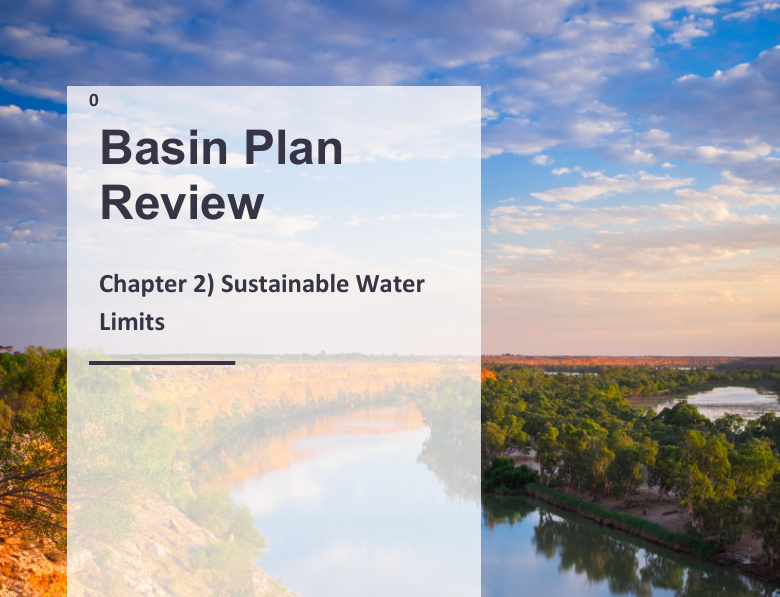
Chapter 2
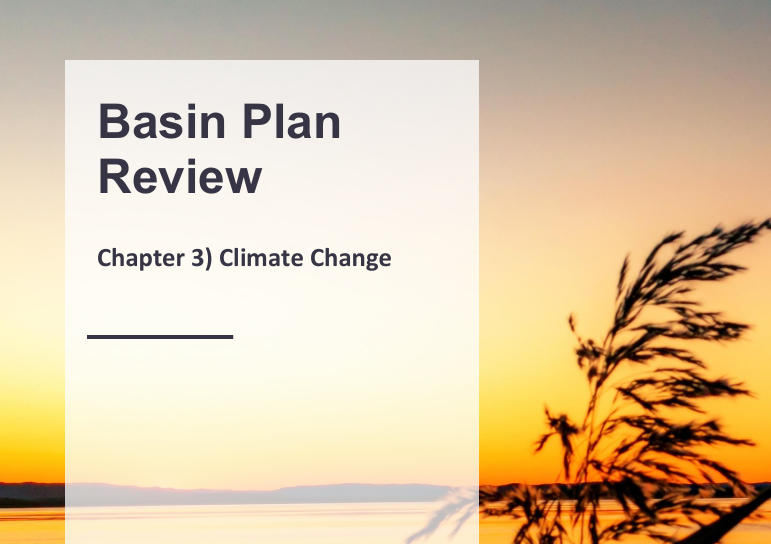
Chapter 3

Chapter 4

Chapter 5
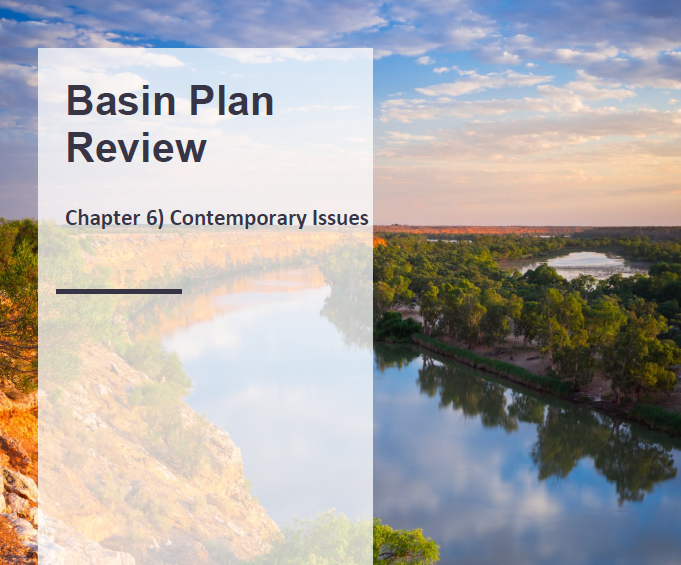
Chapter 5

The combined series of papers including an Introduction and Recommendations on the NIC's Murray Darling Basin Plan Review
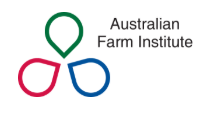
A journal article on a new way of thinking in the Murray Darling Basin using the 'Triple Crown Water Reform Framework'

A summary of socio economic analyses including updated local community case studies on the NIC webpage.
Find out more about our community, and join our mission advocating for the Australian irrigated
agriculture industry.